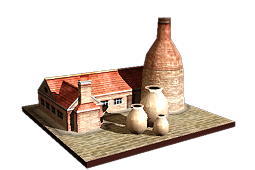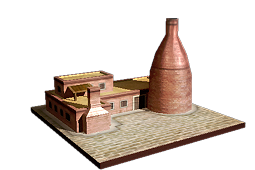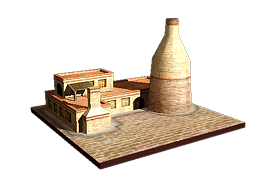Kilns (ETW building)
| Kilns | |||||||
|---|---|---|---|---|---|---|---|
| Category: | Pottery Industry | ||||||
| Level: | 2 | ||||||
| Turns to build: | 4 | ||||||
| Building cost: | 4000 | ||||||
| |||||||
| Requires | |||||||
| Pottery Workshops | |||||||
| Enables | |||||||
| Ceramics Factory | |||||||
Industrial-sized kilns are large ovens for firing hundreds of pottery items in a single batch. The scale of the enterprise demands an end to craft-based production.
With a move to large kilns, unskilled work supplements the craft skills of a potter. Each individual worker masters one skill, such as sticking on handles, using a plate mould, or glazing pottery. This type of working is an early form of the division of labour, allowing faster production with a relatively unskilled (and therefore cheaper) workforce. Pottery at an industrial kiln is still a batch-production process, although the kilns are so large that they can take a week to fill with wares before firing, and at least as long to cool down again afterwards. Factory owners are under no obligation to let the kilns cool before expecting workers to enter and empty them.
Historically, as large-scale production of pottery got underway in the English Midlands by Josiah Wedgewood and others, better transport links followed: there was little point in making fine china if it was going to be smashed to pieces in a cart! Wedgewood’s need to reach markets partly fed into a wave of canal construction, which in turn allowed exploitation of distant resources, thereby creating a virtuous circle of prosperity.




